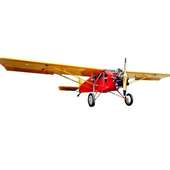- The FBI may be in your router (4/15/25)
- Instead of changing the rules, embrace the purpose of the game (4/11/25)
- Reading the signs and considering the future (4/10/25)
- The limits of tariffs, then and now (4/8/25)
- Good Intentions, but at what cost? (4/4/25)
- Honoring Nebraska’s Vietnam Veterans (4/3/25)
- Keeping an eye out for “Humphrey’s Executor” (4/1/25)
Editorial
Is airline's link of passengers' weight to fare fair?
Wednesday, April 3, 2013
There's been an ongoing debate since the Wright Brothers over what actually makes an airplane fly.
The traditional textbook view is that Bernoulli's principle causes lift because the air that is forced to move faster over the curved top of the wing has less pressure than the slower air passing under the flat bottom of the wing.
Others argue Bernoulli isn't enough to make the plane fly, it's simply that air striking an inclined wing is forced downward, creating lift as the "equal and opposite reaction" of Newton's Law.
Airlines know the truth: it's not physics that make an airplane fly, it's money -- lots and lots of it.
One of the biggest expenses of operating an airline is the fuel required to push the pistons or spin the turbine that turns the propellor or fan that moves the air that allows the plane to overcome the forces of gravity and send the passengers on their way.
Manufacturers spend billions of dollars to shave pounds and ounces off of new airlines for just that reason. A few percentage points of weight reduction translates to millions of dollars of savings over the life of an airliner, perhaps making the difference between profit and loss.
Since deregulation of the airline industry, passengers have seen a decline in amenities such as free meals and pillows, plus have been forced to get used to paying extra for baggage as airlines struggle to make money.
Samoa Air has taken it one step farther, charging passengers by the pound for everything they take aboard the plane -- their bodies included.
"Your weight plus your baggage items is what you pay for. Simple," declares the airline's website.
The airline deserves props for its honesty. It flies just three planes, two 10-seat twin-engine planes and a four-seat, single, none of which have a lot of capacity for extra weight.
Combine that with passengers who share DNA with more than a few American football players, and it becomes clear why weight is an important issue.
Samoa Air tries to keep it lighthearted, and points out that it works both ways. Passengers who check in at 300-plus pounds have paid for the privilege and are allowed extra space and comfort.
Thinner passengers, on the other hand, get away with carrying more luggage.
Will other airlines adopt a direct weight-based fare?
Will Samoa Air ease up a bit when it buys a large Airbus A320-200 later this year for flights to Australia, New Zealand and Fiji?
We don't know, but it is refreshing to see an honest connection made between the laws of physics and finance.

